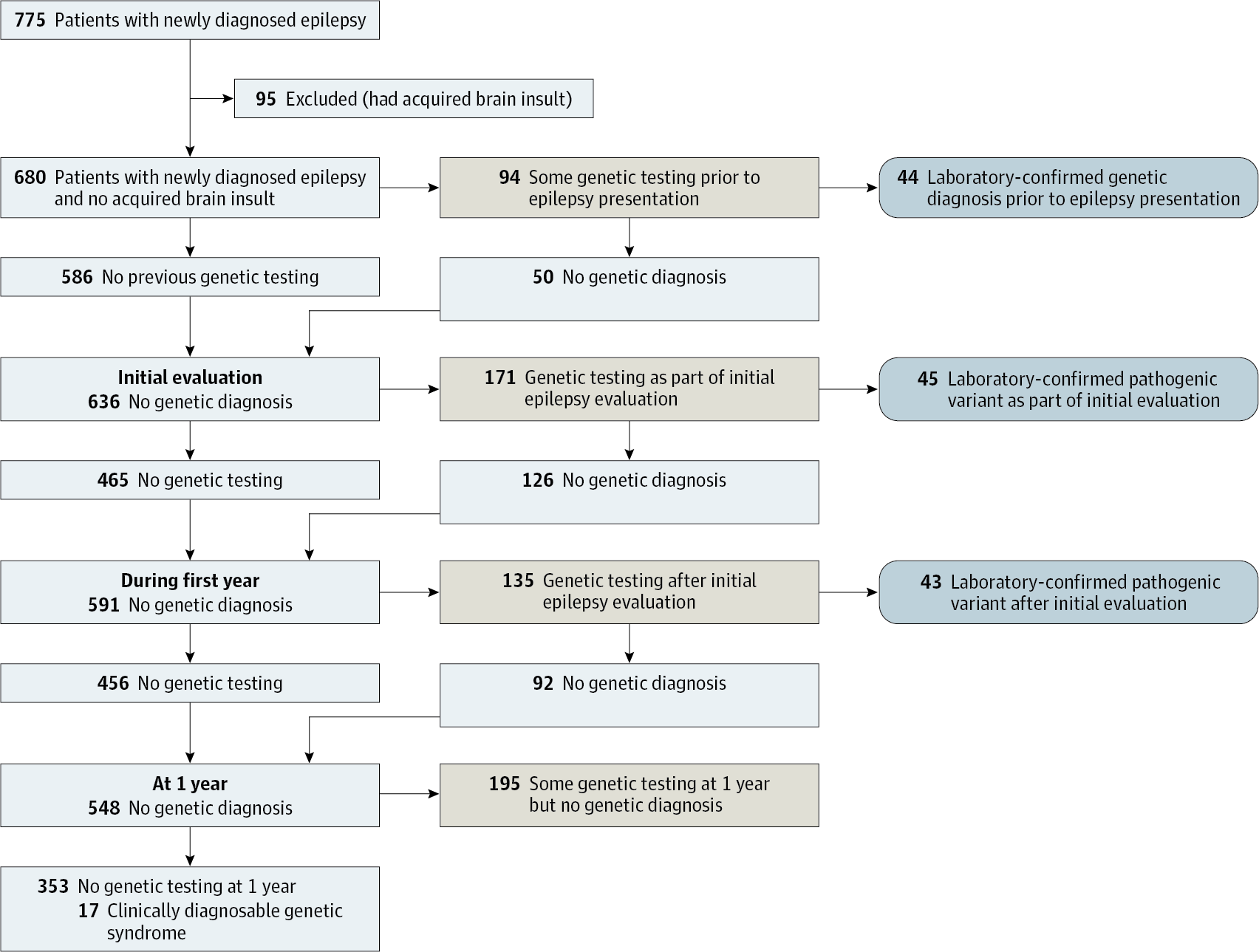当前位置:
X-MOL 学术
›
JAMA Pediatr.
›
论文详情
Our official English website, www.x-mol.net, welcomes your feedback! (Note: you will need to create a separate account there.)
Early-Life Epilepsies and the Emerging Role of Genetic Testing
JAMA Pediatrics ( IF 26.1 ) Pub Date : 2017-09-01 , DOI: 10.1001/jamapediatrics.2017.1743 Anne T Berg 1, 2 , Jason Coryell 3, 4 , Russell P Saneto 5, 6 , Zachary M Grinspan 7, 8, 9 , John J Alexander 10 , Mariana Kekis 10 , Joseph E Sullivan 11 , Elaine C Wirrell 12 , Renée A Shellhaas 13 , John R Mytinger 14, 15 , William D Gaillard 16 , Eric H Kossoff 17, 18 , Ignacio Valencia 19 , Kelly G Knupp 20, 21 , Courtney Wusthoff 22 , Cynthia Keator 23 , William B Dobyns 5, 5, 24 , Nicole Ryan 25, 26 , Tobias Loddenkemper 27 , Catherine J Chu 28 , Edward J Novotny 5, 6, 24, 24, 29, 30 , Sookyong Koh 31
JAMA Pediatrics ( IF 26.1 ) Pub Date : 2017-09-01 , DOI: 10.1001/jamapediatrics.2017.1743 Anne T Berg 1, 2 , Jason Coryell 3, 4 , Russell P Saneto 5, 6 , Zachary M Grinspan 7, 8, 9 , John J Alexander 10 , Mariana Kekis 10 , Joseph E Sullivan 11 , Elaine C Wirrell 12 , Renée A Shellhaas 13 , John R Mytinger 14, 15 , William D Gaillard 16 , Eric H Kossoff 17, 18 , Ignacio Valencia 19 , Kelly G Knupp 20, 21 , Courtney Wusthoff 22 , Cynthia Keator 23 , William B Dobyns 5, 5, 24 , Nicole Ryan 25, 26 , Tobias Loddenkemper 27 , Catherine J Chu 28 , Edward J Novotny 5, 6, 24, 24, 29, 30 , Sookyong Koh 31
Affiliation

|
Importance Early-life epilepsies are often a consequence of numerous neurodevelopmental disorders, most of which are proving to have genetic origins. The role of genetic testing in the initial evaluation of these epilepsies is not established. Objective To provide a contemporary account of the patterns of use and diagnostic yield of genetic testing for early-life epilepsies. Design, Setting, and Participants In this prospective cohort, children with newly diagnosed epilepsy with an onset at less than 3 years of age were recruited from March 1, 2012, to April 30, 2015, from 17 US pediatric hospitals and followed up for 1 year. Of 795 families approached, 775 agreed to participate. Clinical diagnosis of the etiology of epilepsy were characterized based on information available before genetic testing was performed. Added contributions of cytogenetic and gene sequencing investigations were determined. Exposures Genetic diagnostic testing. Main Outcomes and Measures Laboratory-confirmed pathogenic variant. Results Of the 775 patients in the study (367 girls and 408 boys; median age of onset, 7.5 months [interquartile range, 4.2-16.5 months]), 95 (12.3%) had acquired brain injuries. Of the remaining 680 patients, 327 (48.1%) underwent various forms of genetic testing, which identified pathogenic variants in 132 of 327 children (40.4%; 95% CI, 37%-44%): 26 of 59 (44.1%) with karyotyping, 32 of 188 (17.0%) with microarrays, 31 of 114 (27.2%) with epilepsy panels, 11 of 33 (33.3%) with whole exomes, 4 of 20 (20.0%) with mitochondrial panels, and 28 of 94 (29.8%) with other tests. Forty-four variants were identified before initial epilepsy presentation. Apart from dysmorphic syndromes, pathogenic yields were highest for children with tuberous sclerosis complex (9 of 11 [81.8%]), metabolic diseases (11 of 14 [78.6%]), and brain malformations (20 of 61 [32.8%]). A total of 180 of 446 children (40.4%), whose etiology would have remained unknown without genetic testing, underwent some testing. Pathogenic variants were identified in 48 of 180 children (26.7%; 95% CI, 18%-34%). Diagnostic yields were greater than 15% regardless of delay, spasms, and young age. Yields were greater for epilepsy panels (28 of 96 [29.2%]; P < .001) and whole exomes (5 of 18 [27.8%]; P = .02) than for chromosomal microarray (8 of 101 [7.9%]). Conclusions and Relevance Genetic investigations, particularly broad sequencing methods, have high diagnostic yields in newly diagnosed early-life epilepsies regardless of key clinical features. Thorough genetic investigation emphasizing sequencing tests should be incorporated into the initial evaluation of newly presenting early-life epilepsies and not just reserved for those with severe presentations and poor outcomes.
中文翻译:

生命早期癫痫和基因检测的新兴作用
重要性 生命早期的癫痫通常是多种神经发育障碍的结果,其中大部分被证明具有遗传起源。基因检测在这些癫痫的初步评估中的作用尚未确定。目的提供对早期癫痫基因检测的使用模式和诊断率的当代描述。设计、设置和参与者 在这个前瞻性队列中,从 2012 年 3 月 1 日至 2015 年 4 月 30 日期间,从 17 家美国儿科医院招募了 3 岁以下新诊断癫痫儿童,并随访了 1年。在接触的 795 个家庭中,775 个同意参与。癫痫病因的临床诊断基于在进行基因检测之前可用的信息进行表征。确定了细胞遗传学和基因测序研究的额外贡献。暴露基因诊断测试。主要结果和措施实验室确认的致病性变异。结果 在研究的 775 名患者中(367 名女孩和 408 名男孩;中位发病年龄为 7.5 个月 [四分位距,4.2-16.5 个月]),95 名 (12.3%) 患有脑损伤。在其余 680 名患者中,327 名 (48.1%) 接受了各种形式的基因检测,在 327 名儿童中的 132 名 (40.4%; 95% CI, 37%-44%) 中确定了致病变异:59 名儿童中的 26 名 (44.1%)核型分析,188 例中的 32 例(17.0%)使用微阵列,114 例中的 31 例(27.2%)使用癫痫组,33 例中的 11 例(33.3%)使用完整外显子组,20 例中的 4 例(20.0%)使用线粒体组,以及 28 例(94 例) 29.8%) 与其他测试。在最初的癫痫表现之前确定了 44 种变异。除畸形综合征外,结节性硬化症儿童(11 人中的 9 人 [81.8%])、代谢性疾病(14 人中的 11 人 [78.6%])和脑畸形(61 人中的 20 人 [32.8%])的致病率最高。446 名儿童中的 180 名 (40.4%) 接受了一些检测,这些儿童的病因在没有基因检测的情况下仍然未知。在 180 名儿童中的 48 名中发现了致病变异(26.7%;95% CI,18%-34%)。无论延迟、痉挛和年轻,诊断率均大于 15%。癫痫组(96 个中的 28 个 [29.2%];P < .001)和整个外显子组(18 个中的 5 个 [27.8%];P = .02)的产率高于染色体微阵列(101 个中的 8 个 [7.9%]) . 结论和相关性 遗传调查,特别是广泛的测序方法,无论关键临床特征如何,在新诊断的早期癫痫中都有很高的诊断率。应将强调测序测试的彻底基因调查纳入对新出现的早期癫痫的初步评估中,而不仅限于那些表现严重且结果不佳的癫痫患者。
更新日期:2017-09-01
中文翻译:

生命早期癫痫和基因检测的新兴作用
重要性 生命早期的癫痫通常是多种神经发育障碍的结果,其中大部分被证明具有遗传起源。基因检测在这些癫痫的初步评估中的作用尚未确定。目的提供对早期癫痫基因检测的使用模式和诊断率的当代描述。设计、设置和参与者 在这个前瞻性队列中,从 2012 年 3 月 1 日至 2015 年 4 月 30 日期间,从 17 家美国儿科医院招募了 3 岁以下新诊断癫痫儿童,并随访了 1年。在接触的 795 个家庭中,775 个同意参与。癫痫病因的临床诊断基于在进行基因检测之前可用的信息进行表征。确定了细胞遗传学和基因测序研究的额外贡献。暴露基因诊断测试。主要结果和措施实验室确认的致病性变异。结果 在研究的 775 名患者中(367 名女孩和 408 名男孩;中位发病年龄为 7.5 个月 [四分位距,4.2-16.5 个月]),95 名 (12.3%) 患有脑损伤。在其余 680 名患者中,327 名 (48.1%) 接受了各种形式的基因检测,在 327 名儿童中的 132 名 (40.4%; 95% CI, 37%-44%) 中确定了致病变异:59 名儿童中的 26 名 (44.1%)核型分析,188 例中的 32 例(17.0%)使用微阵列,114 例中的 31 例(27.2%)使用癫痫组,33 例中的 11 例(33.3%)使用完整外显子组,20 例中的 4 例(20.0%)使用线粒体组,以及 28 例(94 例) 29.8%) 与其他测试。在最初的癫痫表现之前确定了 44 种变异。除畸形综合征外,结节性硬化症儿童(11 人中的 9 人 [81.8%])、代谢性疾病(14 人中的 11 人 [78.6%])和脑畸形(61 人中的 20 人 [32.8%])的致病率最高。446 名儿童中的 180 名 (40.4%) 接受了一些检测,这些儿童的病因在没有基因检测的情况下仍然未知。在 180 名儿童中的 48 名中发现了致病变异(26.7%;95% CI,18%-34%)。无论延迟、痉挛和年轻,诊断率均大于 15%。癫痫组(96 个中的 28 个 [29.2%];P < .001)和整个外显子组(18 个中的 5 个 [27.8%];P = .02)的产率高于染色体微阵列(101 个中的 8 个 [7.9%]) . 结论和相关性 遗传调查,特别是广泛的测序方法,无论关键临床特征如何,在新诊断的早期癫痫中都有很高的诊断率。应将强调测序测试的彻底基因调查纳入对新出现的早期癫痫的初步评估中,而不仅限于那些表现严重且结果不佳的癫痫患者。



























 京公网安备 11010802027423号
京公网安备 11010802027423号